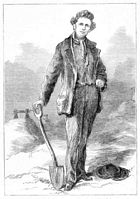Women were a rare sight on the goldfields in the early days. Around the diggings of Golden Point late in 1851, there were only about ten women amid six hundred men. Official estimates tallied the total population on the Victorian goldfields in 1853 as 46,550 men, 10,747 women, and 11,590 children. Gold digging was an almost exclusively male activity. The demanding physical nature of the labour (which, as La Trobe noted, soon sent a number of men packing) made it a difficult proposition for women. The fact that at the beginning of the rushes it was not clear that women needed mining licences also suggests it was not conceived as a female occupation. Yet, although there is no record of a goldmine worked exclusively by women, it was not unusual to see them fossicking for gold and, working beside the men of the family, washing gold dirt. One observer commented on sighting a woman ‘with her clothes held between her knees, rocking the cradle with the untiring energy of a man’ and there was enough of this sort of activity to spark debate in some places on whether women should require licences.
The majority of women on the goldfields juggled assisting their men digging with domestic duties and rearing children. On the Ballarat goldfields in 1854, only two hundred and eight of over four thousand women living there were officially recorded as in paid employment. Most of these were domestic servants, but there were also a handful of women working as storekeepers, milliners, and dressmakers. However, research suggests that as the frontier societies developed, women took up an unusual range of occupations. Patricia Grimshaw and Charles Fahey found that by the end of the 1850s in Castlemaine, women were working in a number of traditional male occupations: there were female printers, cattle dealers, quarry men, brick makers, and blacksmiths. Other women made the most of less official modes of employment. The large number of single men on the goldfields created a demand for prostitution, and contemporary observers noted a number of women working in the sly-grog trade.
For some women the decision to accompany their husbands to the goldfields – even when it meant leaving family in another country and, at least initially, suffering crude living conditions – was to be celebrated. A working-class woman, Lucy Hart, whose husband had success digging, wrote happily to her mother in England that he was ‘now his own Master’ and that she would ‘not come back to England unless I had enough to keep me without work on no account neither would my husband.’ For other women, life amidst the isolated, male-dominated gold societies proved a lonely, alienating experience. Elizabeth Skinner, who suffered as a result of her husband’s unsuccessful pursuit of gold, recalled being lonely and sick and fainting while attending to her children, and wrote: ‘How one longed for mothers and sisters at such times and envied the poorest women at home who in sickness generally have some relative near.’
Historian Margaret Anderson has argued that, given conventional wisdom’s dictate that the goldfields were ‘no place for a lady’, the mere presence of women on the diggings, particularly middle-class women like Emily Skinner, ‘represented a victory of sorts.’ Most of these women had to insist on accompanying their husbands as they travelled the goldfields rather than, as was more common, being left behind in Melbourne or at an early rush site. And not all found the experience as dispiriting as Skinner. Some found that the unconventional nature of digger society freed them, to an extent, from strict notions of female propriety. While, as Martha Clendinning observed, for the working class almost ‘all species of employment for women seemed perfectly natural if they could carry it on with success,’ for middle-class women many occupations were not considered respectable. Thus, Martha and her sister made their husbands laugh when they decided to set up as storekeepers on the diggings. The women weathered the ridicule and managed a successful store selling groceries, baby clothes, and dress materials until the area became more settled. Then the pressures of competition and the re-assertion of more traditional opinions regarding the role of ‘respectable’ women led Martha to sell-up and, not unhappily, focus on ‘make[ing] our home fit for a lady and her doctor husband to occupy.’
Clendinning and even Skinner were better off than many women left deserted in Melbourne to fend for themselves, or dependent on not just feckless but violent husbands. On the goldfields crude living conditions compounded the stress on less than harmonious unions and contemporary observers bear testament to not infrequent domestic abuse. However, convention, a lack of welfare, and the difficulty of women achieving economic independence, meant most women in this situation were effectively trapped. Although there were employment opportunities for women, females were generally not paid at a rate intended to support an individual, let alone a family. Thus, most women at the time had few real alternatives to getting and remaining married. And, while the imbalance of the sexes in theory made for a woman’s market, in practice, as Anderson has put it, ‘marriage was as much a lottery for women as gold seeking was for men.’



